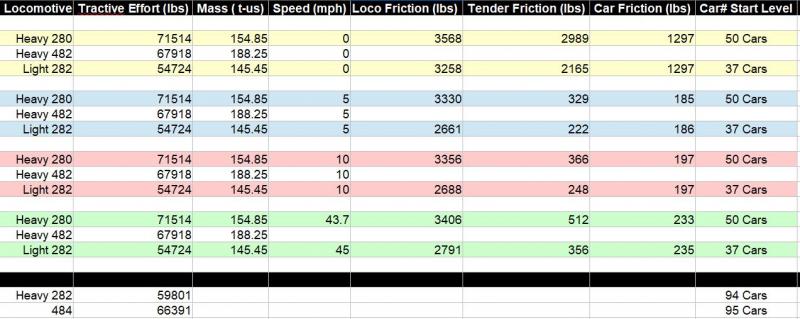 scottb613, on 31 January 2020 - 11:05 AM, said:
scottb613, on 31 January 2020 - 11:05 AM, said:
Sorry - one more question - did anything it that article I linked standout as new data that might prove beneficial to our cause ?
Firstly, there is also a third part to the series that can be found on pg 204 of the same publication.
The following information was of interest to me.
In part 1 of the series the following statement is made, in which static friction can be equated to starting resistance, and kinetic friction can be equated to rolling resistance (Davis):
Quote
The static friction of any given car or train is considerably greater than the kinetic friction and kinetic friction is greatest at the instant motion takes place, but decreases rapidly as the speed increases up to a point between five and ten miles per hour depending upon conditions, after which kinetic friction increases as the speed increases.
This confirms the earlier discussion in regard to slack couplers. It also makes it clear to me, that in cases where train slack is unable to be utilized (perhaps as such on a "steeper" grade) then the locomotive may not be able to start its train even when it is at the rated tonnage. Where slack is able to be utilized, then I agree that the statement you quoted earlier suggesting that starting resistance is not an issue would apply. So the point becomes when would it be usable, and when won't it be usable?
In part 3 the following statement is made:
Quote
The values of mechanical resistance that have been used up to the present point represent favorable weather conditions, but as the mechanical resistance of any given car or train at any given speed in creases a:; the temperature decreases and as it is in creased by wind and precipitation , it is necessary to introduce some method by which tonnage ratings can be modified to meet unfavorable weather conditions. This is one of the most important features in connection with tonnage ratings but is probably the least susceptible to an analysis of any practical value.
This alludes to the different tonnage ratings that would apply under different weather conditions.
In part 2 there is a brief discussion about momentum grades, and this to me suggests that tonnage rates on a line section could be increased where there is a momentum grade, as the train would be able to climb the grade with its momentum. However if it was stationary on the grade, or at the base of it, then the train may not be able to start, or climb the grade with the larger tonnage. Hence it would be necessary to reduce the tonnage rating in this instance to enable the train to start or climb the grade.
Overall the articles were interesting, and they have reinforced my thinking on what might be an appropriate test method (scenario) which I have been contemplating for the other performance work on diesel locomotives to validate or use as a reference for code change.

 Log In
Log In Register Now!
Register Now! Help
Help





